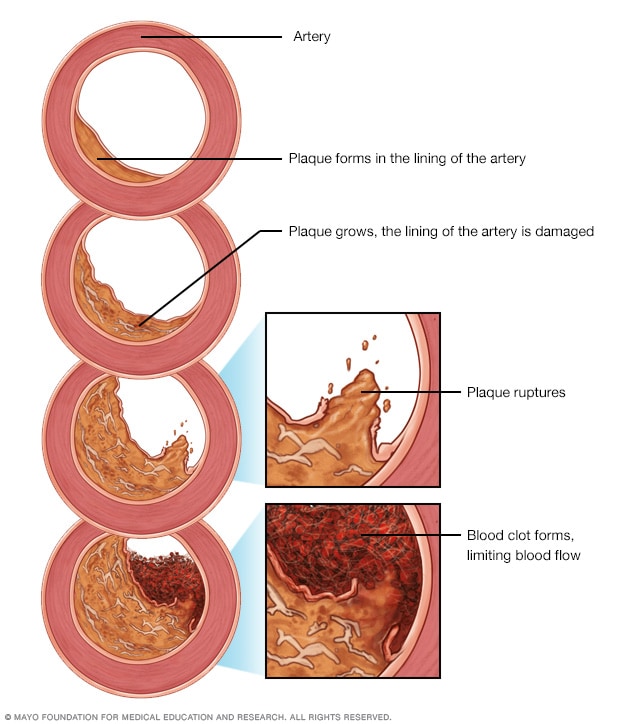Overview
Arteriosclerosis and atherosclerosis are sometimes used to mean the same thing, but there's a difference between the two terms.
Arteriosclerosis occurs when the blood vessels that carry oxygen and nutrients from the heart to the rest of the body (arteries) become thick and stiff — sometimes restricting blood flow to the organs and tissues. Healthy arteries are flexible and elastic. But over time, the walls in the arteries can harden, a condition commonly called hardening of the arteries.
Atherosclerosis is a specific type of arteriosclerosis.
Atherosclerosis is the buildup of fats, cholesterol and other substances in and on the artery walls. This buildup is called plaque. The plaque can cause arteries to narrow, blocking blood flow. The plaque can also burst, leading to a blood clot.
Although atherosclerosis is often considered a heart problem, it can affect arteries anywhere in the body. Atherosclerosis can be treated. Healthy lifestyle habits can help prevent atherosclerosis.
Products & Services
Symptoms
Mild atherosclerosis usually doesn't have any symptoms.
Atherosclerosis symptoms usually don't happen until an artery is so narrowed or clogged that it can't supply enough blood to organs and tissues. Sometimes a blood clot completely blocks blood flow. The clot may break apart and can trigger a heart attack or stroke.
Symptoms of moderate to severe atherosclerosis depend on which arteries are affected. For example:
- If you have atherosclerosis in your heart arteries, you may have chest pain or pressure (angina).
- If you have atherosclerosis in the arteries leading to your brain, you may have sudden numbness or weakness in your arms or legs, difficulty speaking or slurred speech, temporary loss of vision in one eye, or drooping muscles in your face. These signal a transient ischemic attack (TIA). Untreated, a TIA can lead to a stroke.
- If you have atherosclerosis in the arteries in your arms and legs, you may have symptoms of peripheral artery disease, such as leg pain when walking (claudication) or decreased blood pressure in an affected limb.
- If you have atherosclerosis in the arteries leading to your kidneys, you may develop high blood pressure or kidney failure.
When to see a doctor
If you think you have atherosclerosis, talk to your health care provider. Also pay attention to early symptoms caused by a lack of blood flow, such as chest pain (angina), leg pain or numbness.
Early diagnosis and treatment can stop atherosclerosis from worsening and prevent a heart attack, stroke or another medical emergency.
Causes
Development of atherosclerosis

Development of atherosclerosis
If there's too much cholesterol in the blood, the cholesterol and other substances may form deposits called plaque. Plaque can cause an artery to become narrowed or blocked. If a plaque ruptures, a blood clot can form. Plaque and blood clots can reduce blood flow through an artery.
Atherosclerosis is a slowly worsening disease that may begin as early as childhood. The exact cause is unknown. It may start with damage or injury to the inner layer of an artery. The damage may be caused by:
- High blood pressure
- High cholesterol
- High triglycerides, a type of fat (lipid) in the blood
- Smoking or chewing tobacco
- Diabetes
- Insulin resistance
- Obesity
- Inflammation from an unknown cause or from diseases such as arthritis, lupus, psoriasis or inflammatory bowel disease
Once the inner wall of an artery is damaged, blood cells and other substances may gather at the injury site and build up in the inner lining of the artery.
Over time, fats, cholesterols and other substances also collect on the inner walls of the heart arteries. This buildup is called plaque. Plaque can cause the arteries to narrow, blocking blood flow. The plaque can also burst, leading to a blood clot.
Risk factors
Hardening of the arteries occurs over time. Aging is a risk factor for atherosclerosis. Other things that may increase the risk of atherosclerosis include:
- A family history of early heart disease
- An unhealthy diet
- Diabetes
- High blood pressure
- High cholesterol
- High levels of C-reactive protein (CRP), a marker of inflammation
- Lack of exercise
- Obesity
- Sleep apnea
- Smoking and other tobacco use
Complications
The complications of atherosclerosis depend on which arteries are narrowed or blocked. For example:
- Coronary artery disease. When atherosclerosis narrows the arteries close to your heart, you may develop coronary artery disease, which can cause chest pain (angina), a heart attack or heart failure.
- Carotid artery disease. When atherosclerosis narrows the arteries close to your brain, you may develop carotid artery disease. This can cause a transient ischemic attack (TIA) or stroke.
- Peripheral artery disease. When atherosclerosis narrows the arteries in your arms or legs, you may develop blood flow problems in your arms and legs called peripheral artery disease. This can make you less sensitive to heat and cold, increasing your risk of burns or frostbite. Rarely, a lack of blood flow to the arms or legs can cause tissue death (gangrene).
- Aneurysms. Atherosclerosis can also cause aneurysms, a serious complication that can occur anywhere in the body. Most people with aneurysms have no symptoms. Pain and throbbing in the area of an aneurysm may occur and is a medical emergency. If an aneurysm bursts, it can cause life-threatening bleeding inside the body.
- Chronic kidney disease. Atherosclerosis can cause the arteries leading to the kidneys to narrow. Narrowing of these arteries prevents enough oxygen-rich blood from reaching the kidneys. The kidneys need enough blood flow to help filter waste products and remove excess fluids.
Prevention
The same healthy lifestyle changes recommended to treat atherosclerosis also help prevent it. These lifestyle changes can help keep the arteries healthy:
- Quitting smoking
- Eating healthy foods
- Exercising regularly
- Maintaining a healthy weight
- Checking and maintaining a healthy blood pressure
- Checking and maintaining healthy cholesterol and blood sugar levels